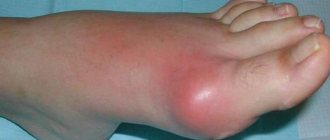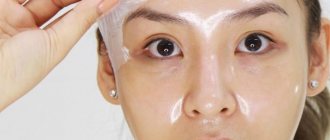Is an allergy to cow's milk treated in a child, what to give to a bottle-fed allergic baby and what should a mother do if her breast milk causes an allergic reaction in the child - these and other popular questions from mothers are answered by Doctor of Medical Sciences, Professor of the Department of Pediatrics with a course Polyclinic Pediatrics named after. Academician G.N. Speransky Federal State Budgetary Educational Institution of Further Professional Education RMANPO of the Ministry of Health of Russia Irina Nikolaevna Kholodova.
— Irina Nikolaevna, how can you understand that a newborn or a 1.5-2 year old child has an allergy?
— I would like to draw the attention of parents to the fact that if there are people in the family who suffer from allergies, then, of course, the likelihood of allergies in the child will be quite high. For example, if only the mother suffers from it and all allergy sufferers are on the mother’s side, then the probability of an allergy is 40-50%, and if on both the mother’s and father’s side, then it is already 80%. That is, allergies are inherited
and in a child it can manifest itself from the first days of life. In young children, skin and gastrointestinal forms of allergies are most common.
Skin allergy
In young children, it is the cutaneous form that predominates (previously it was called exudative-catarrhal diathesis, now it is called atopic dermatitis) - an allergic rash appears on the child’s body. This can be a dry or wet rash, most often with itching.
Gastrointestinal form of allergy
This form is more difficult to diagnose, and it can be very difficult to understand that it is an allergy. Such children may experience severe colic from the first days of life - food is poorly digested, under-oxidized products are formed that irritate the gastrointestinal mucosa and can cause inflammation. In addition, due to impaired fermentation of food, a large amount of gases is formed. Gases stretch the intestines and put pressure on nerves and blood vessels. All this causes spasm and pain.
Subsequently, changes in the character of the stool may appear - there are constipation, but most often diarrhea occurs. Moreover, stool is usually several times a day, and it can be irritating, with a lot of mucus and even streaks of blood. The child begins to eat poorly, there is poor weight gain, and subsequently there may be a slowdown in growth. In such a situation, it is necessary to hospitalize the child to determine the cause - it can be not only an allergy, but also other diseases.
Is milk not for everyone?
The main task of the immune system is to recognize “self” and “foreign” cells. It reacts mainly to substances of protein nature, forming either a “Friend” (so-called immunological tolerance) or “Enemy” (antigen) response. When the response is “Enemy,” specific substances (antibodies) are produced that are aimed at fighting it. But, as with any system, there are failures.
Allergy (atopy) is an example of one such failure, when even friends are blacklisted. The child’s immune system begins to react to BCM inappropriately and excessively, blacklisting it. Beneficial protein turns into an allergen. This reaction is called "hypersensitivity."
The reasons for the occurrence of such “problems” are not reliably known to anyone. Scientists only build hypotheses, accumulate and systematize knowledge. All experts agree that genetic predisposition plays an important role. The only way to break the vicious circle of allergies and help a person is to exclude the causally significant allergen from the diet (environment) of this person.
This is called elimination (and elimination measures).
Signs of an allergic reaction to milk in formula or complementary foods
Allergy to cow's milk protein in infants is widespread, and there has been a lot of talk about it lately. The downside of this increased attention is frequent misdiagnosis. Parents sometimes groundlessly suspect that their baby has an allergy and put him on an irrational diet in this case. At the same time, the opposite situation is also dangerous, when the child continues to be fed with regular formula, milk porridge and cottage cheese, without realizing that he is intolerant. To eliminate both types of errors, you need to have an idea of how an allergy to cow's milk manifests itself.
Symptoms of intolerance can occur in a baby already in the first days after birth. They appear almost immediately after milk protein enters the body. Immediate reactions include respiratory disorders: dry cough, nasal congestion, wheezing, shortness of breath, acute urticaria, Quincke's edema, and anaphylactic shock [3] https://yaallergik.com/. In infants under one year of age, such symptoms are rare.
Much more often, infants have delayed reactions: the allergy appears several hours or days after consuming products that contain cow's milk protein. Two clinical forms predominate: cutaneous and gastrointestinal. In some cases, there is a combination of symptoms from the skin and digestive organs - this makes it easier to diagnose an allergy.
Skin symptoms of cow's milk allergy include characteristic itchy rashes. The rash is concentrated mainly on the face (cheeks, forehead), scalp, buttocks, and on the inside of the elbows and knees. The rash is usually bright red, with small blisters filled with fluid. When they burst, they form a weeping crust, similar to eczematous. The child suffers from itching, which becomes unbearable in the evening and at night. Trying to cope with it, the baby scratches the affected areas, which causes crusts to form.
The gastrointestinal (gastrointestinal) form of protein allergy in a child is much more difficult to determine, because parents can only guess about many of its manifestations. In addition, digestive disorders associated with the immaturity of the gastrointestinal tract are typical for infants, and it is not always clear whether this is normal or pathological.
An allergy to cow's milk protein can occur in approximately 30–40% of children. How to replace cow's milk? THERE ARE CONTRAINDICATIONS. YOU MUST CONSULT A SPECIALIST
Nevertheless, a number of signs suggest that a child is allergic to cow's milk protein:
- Colic . This is normal for the vast majority of babies, but in children with a milk allergy, abdominal pain occurs earlier and is usually more intense. The reason for the pain syndrome is that protein is poorly digested and intermediate products of its breakdown irritate the gastrointestinal mucosa. A lack of enzymes leads to increased gas formation, which also causes increased pain.
- Stool disorders. As a rule, they are expressed in the form of diarrhea (constipation also occurs, but less frequently). Mucus is visible in the stool, and sometimes traces of blood can be seen. This is a consequence of allergic proctitis or enterocolitis.
- Regurgitation and vomiting after eating.
- Decreased appetite and growth retardation. Babies with allergies often refuse food, are reluctant to breastfeed or bottle, and have trouble gaining weight.
Atopic diseases. How to suspect them?
Often people don’t even know about the diagnoses listed above because they don’t see a doctor.
The following symptoms should alert you:
- seasonal nasal congestion or runny nose with copious mucus production
- occasional lacrimation
- bouts of coughing and sneezing
- prolonged dry cough
- bouts of difficulty breathing
- wheezing
- rashes, redness and itching of the skin
- skin prone to dryness and flaking (periods or after contact with something)
- redness and/or other skin reaction to sun or cold exposure
- skin irritation after contact with something
- reactions to insect bites
- reactions to drugs
If the above symptoms occur, then there is a high probability of atopy. In this case, it is better to seek advice from a specialist. If you have allergies, be sure to tell your pediatrician about it and monitor your child’s diet.
Symptoms of food allergies in infants
1. Manifestations of food allergies are varied. The most common manifestation is a rash. Immediately after an allergen enters the body, an acute allergic reaction—urticaria—may develop. Bright red swollen spots of different sizes and shapes appear on the baby’s skin. A bubble with transparent contents may appear in the center of the spot. Its size can vary from a few millimeters to several centimeters. This rash usually goes away within 1-3 days. But it’s still worth showing the baby to the doctor. Since sometimes a child needs medication, and in case of an extensive rash, or its unfortunate location, even emergency help. You need to remember which product caused this reaction and not give it again.
2. Other types of rash are not as severe. Therefore, it is not always possible to determine a clear connection between its occurrence and the product. Such rashes are usually not bright, small-pointed. They are prone to undulating flow. The rash usually becomes brighter in the evening and fades in the morning. The skin becomes dry, flaky, and sometimes cracks. Most often, such a rash is located on the cheeks, buttocks, outer surfaces of the thighs and forearms. This type of rash requires special attention from specialists - examination and specific treatment.
3 The second most common manifestations are gastrointestinal symptoms. These include: swelling of the mucous membranes of the oral cavity, swelling of the esophagus, single or repeated vomiting. Most often, such symptoms appear acutely, immediately after consuming the allergen. In addition, the baby may experience abdominal pain. He can groan, be capricious, and kick his legs. Food allergies can manifest as loose stools. This can be either diarrhea or constipation. Less obvious signs of a food allergy in a baby may include frequent heavy regurgitation, low weight gain, poor appetite, and weakness. Manifestations from the gastrointestinal tract may occur with or without a rash.
4 Much less often in infancy, manifestations from the respiratory system are possible; if food gets into the mucous membranes, swelling of the upper respiratory tract may occur. This condition is acute and life-threatening. It requires immediate medical attention. With prolonged contact with the allergen, allergic rhinitis or asthma may develop. More often, such reactions appear not after ingestion of food, but after inhalation of its particles. The most common cause of respiratory allergies is inhalation of fumes from cooking or frying fish.
In addition, there are severe acute allergic reactions such as angioedema or anaphylactic shock. Such reactions occur immediately after contact with the allergen and develop very quickly. They are extremely rare and require emergency medical attention.
Is it possible to prevent the development of ABCM?
Yes.
During pregnancy, the process of “friend/foe” recognition begins. The future mother’s nutrition plays a significant role in this. Products containing choline, methionine, zinc, folic acid, vitamins B6 and B12 can regulate gene function and contribute to the formation of tolerance (body resistance) to CMP.
During breastfeeding, you can limit the consumption of dairy products and other obligate allergens. This will reduce the burden on the child’s body and will also contribute to the formation of an adequate response of the immune system to BCM.
Obligate allergens are foods that often cause allergic reactions: eggs, fish, seafood, legumes: peas, beans, soy, peanuts; nuts, honey, strawberries, pomegranate, kiwi, melon, black currant, mushrooms.
How does an allergy occur?
A protein allergy is a response of the immune system to the entry of a foreign protein into the body. Our own immunity begins to perceive protein molecules as “dangerous strangers.” Protecting the host from an imaginary threat, cells of the immune system produce antibodies, triggering an allergic reaction.
This “war” is reflected in the functioning of internal organs, the condition of the skin and mucous membranes - allergy symptoms appear. It should be noted that proteins are considered the most aggressive and dangerous food allergens, and protein allergy in children and adults is considered the most common form of food allergy.
It turns out that in 90% of cases, food allergies in children are caused by foods: milk, nuts, eggs, peanuts, wheat and soy. Adults are more likely to report allergies to nuts, peanuts, seafood and fish. Food allergies to cow protein, vegetables and fruits are much less common.
In food allergies, protein allergens include:
- milk proteins - casein, alpha-lactalbumin, beta-lactoglobulin;
- sarcoplasmic proteins of fish and various seafood;
- chicken egg white containing mucoproteins (ovomucoid, conalbumin, ovalbumin);
- beef and veal proteins - in case of cross-allergy to milk protein;
- nut proteins are the most aggressive peanut allergens;
- cereal proteins (wheat, oats, buckwheat, sesame);
- legume proteins (beans, peas).
Naturally, products containing these proteins “automatically” become allergens. For example, everyone’s favorite chocolate contains milk, soy, and nut proteins. If you are allergic to any of these components, you will also be allergic to the chocolate itself.
Allergies can occur to any food product. Allergies to chicken protein, cow's milk, wheat, corn, peanuts, tree nuts and seafood are the most common.
By the way, protein allergens are found not only in food. Plant pollen allergens are also protein in nature. For example, birch pollen, containing about 40 proteins, has the highest allergic activity. When pollen allergens enter the upper respiratory tract with inhaled air, they also provoke allergies. Doctors call this disease “hay fever.”
Allergies to egg whites, milk, wheat and chicken are more common in children. In adults, the leading food protein allergens are cod, wheat, rice, oats, and potatoes.
Many people suffering from food allergies experience cross-allergic reactions to allergens from household dust, plant pollen, mold, animal hair, chicken feathers, and meadow grasses.
Egg white allergens can cause cross-allergy to baked goods, influenza vaccines and tick-borne encephalitis.
An allergy to wheat can be combined with an allergy to nuts, kiwi, bananas, and corn.
If supplementary feeding is needed?
In the first three months, all children, regardless of the degree of risk of developing CM, are recommended to use only mixtures with specially prepared protein. Their degree of allergenicity is significantly reduced, which is why they are called hypoallergenic. The NutrilakPremium Hypoallergenic mixture is additionally enriched with probiotics and food substrate for their growth and development (prebiotics). The NutrilakPremium Hypoallergenic fat component in combination with lutein best provides all the needs for the development of the child’s brain, vision and motor skills.
Treatment
The basis of treatment is the complete exclusion of cow's milk and products made from it from the child's diet. It is necessary to exclude beef, as cross-allergic reactions to beef proteins and dairy products are common. For artificial feeding, formulas are used that do not contain unmodified proteins from cow's milk or the milk of other mammals. You can choose a whey protein hydrolyzate-based mixture or an amino acid-based mixture. The amino acid-based mixture is suitable for children with severe allergic reactions (angioedema, anaphylactic shock, intense vomiting and others). It is strictly contraindicated to use soy, almond, rice or other types of plant milk as formula for artificial feeding2.
The introduction of complementary foods should begin in accordance with age standards and type of feeding. Dairy and fermented milk products are excluded from complementary foods. The minimum duration of the elimination diet is set by the attending physician depending on the severity of the allergy (on average, at least 6-12 months, and in severe cases, at least 18 months). After a therapeutic diet, the diet gradually expands.
For severe symptoms of the disease, treatment may include second-generation antihistamines. The medicine, dosage and duration of administration are determined by the doctor after examining the child. Taking antiallergic medications for prevention is not recommended. In mild cases of ABCM, unpleasant symptoms can be completely eliminated without the help of medications by adhering to a therapeutic diet1.
How does an allergy to BCM manifest in a baby?
Symptoms of ABCM can be very different.
With skin lesions:
- the appearance of dry skin, sometimes in the form of plaques
- redness of certain areas of the skin (around the mouth, arms and legs, cheeks, chest and abdomen)
- the appearance of weeping spots and crusts with severe itching
- long lasting diaper rash
Involving the gastrointestinal tract:
- private regurgitation
- colic
- constipation
- diarrhea
- mucus in stool
- blood-streaked stool
- poor appetite and slow weight gain
The mucous membranes of the eyes, nose and respiratory tract may be involved with the following symptoms:
- lacrimation
- prolonged runny nose
- distant wheezes
- paroxysmal cough
All this can also affect the baby’s behavior in the form of:
- irritability
- sleep disorder
- bouts of crying and anxiety
How to recognize a food allergy and not confuse it with other diseases?
Most often, in order to diagnose a food allergy, a doctor only needs an examination and a detailed interview with the mother. Mom can point out that she herself has a food allergy or point the doctor to a specific food. Sometimes it is difficult to make such a diagnosis right away. Then the doctor may order an examination. First, a general blood test. And then, if necessary, specific allergy tests: examination for immunoglobulins, and at a later age, provocative tests. It is these tests that were chosen as the most informative in the latest clinical recommendations. In addition, your baby may need to consult an allergist, dermatologist or gastroenterologist, depending on the symptoms that are bothering him. And also, additional examination from the gastrointestinal tract.
It is important!
If symptoms persist after eliminating the causative allergen from the diet, it may not be a food allergy.
Contact your pediatrician immediately. In this case, a nursing woman needs to return to a balanced diet that includes all foods acceptable in the diet of nursing women (to prevent nutritional deficiencies in both her and the child).
If the baby is on mixed or artificial feeding, then together with the pediatrician it is necessary to decide on the correct selection of nutrition for him.
If the baby is already familiar with complementary feeding products, then together with the doctor, review the menu again. Make changes if necessary. Products containing BCM should be excluded. Keeping a food diary for mother and baby will greatly facilitate the process of finding the allergen and taking measures to eliminate it.
Enterosgel and treatment of protein allergies
Enterosgel sorbent is indispensable for the treatment of food allergies in adults and children. The drug effectively absorbs and removes allergens from the body, eliminates unpleasant allergy symptoms and helps restore intestinal microflora.
Doctors advise allergy sufferers to use Enterosgel for preventive purposes. For example, in case of possible dietary violations while visiting, on business trips, or having to eat outside the home.
How to confirm the diagnosis of ABCM?
There are not many tests in a doctor's arsenal for this, and there are no gold standards. There is no analysis that can confirm the diagnosis with 100% certainty.
The immunological tests performed can be divided into:
- nonspecific, confirming the allergic nature of inflammation
- specific, indicating the degree of significance of the influence of a particular allergen
Difficulties in diagnosing ACM It is extremely rare that only one allergen (CAM) is the cause, the trigger that triggers inflammation
- Most often these are several allergens at once (polyvalent allergy)
- There is cross-reaction between different groups of products
- If the child is breastfed, immunological tests are difficult to interpret (due to the presence of maternal antibodies in his blood)
Causes of food allergies in newborns
Food allergies in babies who have just been born are very rare. The baby receives only mother's milk. This is food that nature created for your baby and nothing can be better than it. Therefore, the peak age of food allergies in breastfed infants can be considered around 4–5 months, when the baby begins to receive complementary foods - products added to breast milk: vegetables, fruits, cereals, meat, dairy products and others. The situation is somewhat different with bottle-fed babies. The formula itself can cause food intolerances. Therefore, when choosing a mixture, it is better to consult a specialist.
Ways to select nutrition for ABCM
It all depends on the severity of the allergic process, existing symptoms, the age of the child and the type of feeding.
Breastfed
It is enough to organize the mother's nutrition.
With mixed feeding
If supplementary feeding is necessary, experts recommend using a mixture with split protein hydrolyzate. Of these, you can consider the Nutrilak Premium Hypoallergenic mixture.
Compared to whole molecules of cow's milk proteins, the allergenicity of its split protein is reduced by 100,000 times. Nutrilak Premium Hypoallergenic is suitable for the prevention of allergies in children at risk and the treatment of mild skin manifestations.
Causes of allergies
— What could be the causes of an allergic reaction?
— The leading factor is heredity, as we have already said. The second point is the immaturity of children (immaturity of the central nervous system, gastrointestinal tract and all its departments - enzymatic immaturity, lack of hydrochloric acid, impaired motor skills). The most significant allergen in children of the first year of life all over the world is cow's milk protein.
In our country, according to Russian pediatricians, an allergy to cow's milk protein is registered in 30-40% of children
. Such an allergy is most often non-atopic, non-allergic, that is, independent of the level of immunoglobulin E. Therefore, there is no need to be tested for its content in the blood or coprofiltrates. Non-atopic allergies, fortunately, go away with age in most children, but in some children it turns into a real IgE-dependent allergy.
— Can allergies be triggered by intestinal dysbiosis?
— For young children, the concept of dysbiosis does not exist, because their intestinal microbiota is developing. The process begins at birth and ends at approximately 3 years of age. However, in children at risk (premature, malnourished, children born by cesarean section and others), disruptions in the formation of microbiota are possible, which can affect the formation of allergies. Therefore, when feeding them if the mother has hypogalactia, many manufacturers introduce pre- and probiotics into the mixture to improve the formation of the microbiota. If a child is breastfed, he is prescribed a pre- or probiotic drug - but this is not recommended for all children, but only for children at risk. Healthy children do not need to be prescribed anything - their microbiota formation process will systematically end by the age of three.
— Irina Nikolaevna, you can often come across the concepts “cow’s milk protein allergy” and “cow’s milk protein intolerance” - are they different things or the same thing?
— For young children these are almost the same concepts. We can only diagnose them clinically and not laboratory-based. The conditions manifest themselves as a clinical symptom of allergy: atopy on the skin or gastrointestinal disorder. But there is also a mixed form - dermatogastrointestinal lesion. For older children, there are the concepts of “cow's milk protein allergy” and “intolerance”, and with the help of diagnostic methods (for example, immunoglobulin E, general and specific) one can understand whether there is an allergy or not. If the product is intolerant, the child experiences discomfort after taking it, there may be pain and other manifestations, but the levels of immunoglobulin E, general and specific, are normal.
— That is, it is impossible to confirm an allergy to cow’s milk protein in a child at an early age?
— For a child under 1 year of age, there are no diagnostic tests, not only in Russia, but throughout the world. Because in children, 80% of allergies are not IgE-dependent allergies. We do not test the level of total immunoglobulin E or specific immunoglobulins in these children, because we may get a negative reaction if allergies are present.
The only method that allows you to understand whether a baby is allergic to cow's milk protein or not is a provocative test.
However, not every mother will agree to it. Imagine a child comes to you whose entire skin is a solid crust due to an allergy. The child is bottle-fed; cow's milk-based formulas are discontinued and medicinal formulas (complete hydrolyzate or amino acid mixtures) are prescribed. He cleanses everything, everything is fine, because he completely eliminated the whole protein of cow's milk. What should mom do next? See clear skin, rejoice and try to reintroduce cow's milk formula into your baby's diet in order to understand whether he has an allergy or not. If there is an allergy, the child will “aggravate the skin” again; if there is no allergy, then the skin will be clear. This is called a provocative test.
Of course, not every mother will want to stop hydrolysates, especially since it is very difficult to accustom a child to bitter hydrolysates. But it is the provocative test that is the gold standard for diagnosing allergies in the first year of life.
In children after one year of age, in case of severe manifestations of atopy on the skin or gastrointestinal form, you can look at immunoglobulin E in the blood serum
, but still international experience shows that it is best to carry out diagnostic tests after the age of two.
— If a mother exclusively breastfeeds her child, does she need to adjust her diet if she has a history of allergies?
“In this case, we recommend the mother a dairy-free diet starting from the maternity hospital. We exclude not only milk, but also all dairy products - kefir, yogurt, cottage cheese, sour cream, butter, etc. In addition, we exclude veal and beef, because this is the same protein that a child can react to. But all this is only if the child has a family history or has manifestations of allergies in the form of gastrointestinal disorders or skin rashes. If the child is not burdened by heredity, there are no clinical symptoms of allergies, then the mother receives milk, she does not need such strict diet therapy.
— What recommendations can be given for a child on mixed or completely artificial feeding?
— Consider artificial feeding when the mother has agalactia
- there is no milk at all, and the doctor switches the child to formula.
- Firstly, for a healthy child without signs of allergies, the doctor chooses from two types of formulas that are registered, tested and well known in our country - a mixture with cow's milk or a mixture with goat's milk. The doctor can prescribe both.
- Secondly, for a healthy child with existing risk factors for developing allergies, it is preferable to prescribe goat milk formulas, even if the baby only needs to be supplemented. They are considered less allergenic. But I emphasize once again - provided that the child is completely healthy. If, due to some circumstances, the doctor or mother does not want to use a formula with goat’s milk, you can prescribe any premium formula of formula “1” with cow’s milk.
- Thirdly, if a child already has signs of an allergy, we cannot prescribe formulas with either cow's milk or goat's milk. And we can’t even choose the “Comfort” mixture, which contains partial hydrolyzate. In this case, we must prescribe a medicinal mixture to the child: it can be a complete hydrolyzate, casein or whey, or an amino acid mixture in case of severe allergies.
It is important!
Nutrilak Premium Hypoallergenic contains lactobacilli L.rhamnosus LGG® - this is the most effective and safe probiotic for children from birth, used for the treatment and prevention of atopic dermatitis and eczema.
With artificial feeding
If the baby has pronounced skin manifestations, there are crusts and areas with weeping, or there is persistent heavy regurgitation, streaks of blood in the stool, then only deep hydrolysates (for example, Nutrilak PEPTIDE MCT) or amino acid mixtures can be used from mixtures.
Children over 6 months have a wider choice of food: there is more possibility of using complementary foods and soy mixtures (for example, NutrilakPremium Soya).
Is it possible to outgrow ABCM?
No!
If tolerance has not been formed and hypersensitivity to CMP remains, then the allergic inflammatory process occurs in the background. It may not be as pronounced, but it continues! Gradually, the foundation is laid for the development of chronic pathological diseases, turning into a time bomb.
What else is useful to know?
In the process of forming a reaction to an allergen, not only the response of the immune system is important, but also the background against which it unfolds.
It is known that products such as chocolate, cheese, citrus fruits, vinegar, nuts, marinades, etc. are a source of special substances (histamine liberators). They help maintain allergic inflammation by adding fuel to this fire. Limiting their intake or completely eliminating them will reduce the manifestations of atopy and help alleviate the child’s condition.
The smallest friends are microorganisms. Most of them live in the large intestine. They are our great helpers. Their contribution to curbing allergic reactions and forming the correct response to food is difficult to overestimate. More and more studies are confirming this. And if your own intestinal inhabitants can’t cope with this, then trusted friends – probiotics – can come to the rescue. All over the world, only two microorganisms have the largest evidence base on the antiallergic effect - LGG and BB-12 from Chr. Hansen. One of them even has its own website (https://www.lgg.com/).
“Provocateurs” of allergies
Animal proteins pose a greater danger as allergens than plant proteins. Most often, allergies are caused by animal proteins such as albumin, casein and parvalbumin.
Albumin is found in fish, meat, and chicken eggs. The most common allergies are egg protein allergy, fish protein allergy, chicken protein allergy and beef protein allergy. Cooking, smoking or salting these products does not destroy protein allergens!
Fish and seafood also contain the proteins parvalbumin and tropomyazin. These proteins are not destroyed by heat treatment or exposure to gastric juice.
Casein is the second representative of animal proteins, which is found in abundance in milk and fermented milk products. Allergies occur to both cow's milk and goat protein. This protein is not destroyed during heat treatment, so the statement that milk proteins do not cause allergies after boiling is erroneous
Children are more prone to food allergies to milk protein, because their immunity is still weak and exposed to many irritants.
This begs the question: if you are allergic to cow protein, can a child drink milk from other animals? Most children react the same way to goat's or sheep's milk, so replacing cow's milk with milk from other animals is not recommended.
It is worth noting that milk intolerance in children is combined with an allergy to soy protein, so soy-based infant formulas can also cause food allergies. The pediatrician selects a mixture for protein allergies based on highly hydrated amino acids.
By the way, many children can “outgrow” a milk allergy. This fact can most likely be associated with the maturation of the immune system.
What if it doesn’t outgrow? Then you can reduce the manifestations of protein allergies thanks to the Enterosgel sorbent! The advantages of the drug are that it is safe for children, does not disturb the intestinal microflora, is easy to use and does not remove beneficial substances and microelements from the body due to its special structure.
Eating problems due to milk
Milk allergy is becoming more common and is increasingly causing hospitalization. Food allergies are a serious health problem, and their symptoms extend beyond the reactions of the digestive system.
Research in recent years shows that more and more children are being hospitalized due to digestive problems, and more than 40% of them are hospitalized due to cow's milk allergy. The duration and severity of symptoms of this type of allergy increase. On the other hand, restricting an infant's diet can potentially lead to deterioration in the child's growth, development, and overall health.
Milk substitutes in the diet
In recent years, soybean has been considered one of the substitutes for cow's milk, mainly soy milk and soy-based products.
It includes, among others, vitamin E and B, calcium, protein, magnesium, iron, phosphorus and lecithin. However, soy is not always safe. Soy products are not recommended for children under 6 months of age. Moreover, in severe allergies, the intestinal mucosa may be receptive to soy protein, resulting in soy allergy. You can also use coconut, rice or nut milk. Excluding cow's milk, you need to take care of the right amount of calcium in your diet. Its sources: eggs, fish (which contain bones, for example, sardines, sprats), as well as plant products: bread, flour, coarse cereals, dried legume seeds, vegetables (for example, spinach, chard, cabbage), nuts, cocoa, figs and dried apricots. Also allowed: meat, cereals, bread and eggs. Of course, fruits are also highly recommended, but you should be careful with citrus fruits. The menu can be based on these products; you can additionally maintain calcium levels, for example, using tablets.
Forbidden sweets, that is, sweets containing milk, can be replaced with dairy-free analogues, for example, milk chocolate can be replaced with dark chocolate or dried fruit candies, and a purchased cake can be prepared independently by baking it without adding milk.










